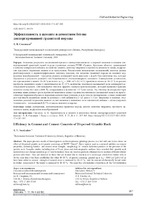Эффективность в цементе и цементном бетоне диспергированной гранитной породы
Another Title
Efficiency in Cement and Cement Concrete of Dispersed Granitic Rock
Bibliographic entry
Смоляков, А. В. Эффективность в цементе и цементном бетоне диспергированной гранитной породы = Efficiency in Cement and Cement Concrete of Dispersed Granitic Rock / А. В. Смоляков // Наука и техника. – 2018. – №4. - С. 297-305.
Abstract
Изложены результаты исследований процесса диспергации (помола) в шаровой мельнице и влияния диспергированной гранитной горной породы (гранитных отсевов РУПП «Гранит», Брестская область), применяемой в качестве минеральной добавки, на свойства цемента, кинетику твердения и прочность цементного камня, морфологию продуктов гидратации цемента в ее присутствии. Результатами комплексных исследований, включая данные рентгенофазового и дериватографического анализов, показано, что вещество гранитной породы не изменяет морфологию новообразований – продуктов реакции клинкерной части вяжущего с водой. Они идентичны тем, которые образуются в результате реакций с ней бездобавочного (чистоклинкерного) вяжущего. Одновременно установлено, что при введении в цемент 10–20 % молотого до Sуд ∼ 3000 см²/г (0,3 м²/г) гранитного отсева до 20–25 % возрастает прочность цементного камня и увеличивается на 10–15 % количество химически связываемой воды клинкерной составляющей вяжущего. Обосновывается гипотеза эффекта «центров кристаллизации», который проявляют фракции молотого отсева ≤0,3 мкм (≤3000 Å), содержащиеся в количестве ∼15 % его массы. Эту гипотезу подтверждают приведенные выше данные о росте прочности цементного камня и количества химически связываемой воды в их присутствии при твердении образцов в нормально-влажностных условиях, в воде и после пропаривания, а также очевидный рост прочности цементного камня на вяжущем с этой добавкой (в 2–2,5 раза в 1–3 сут. твердения) в условиях «торможения» реакций гидратации цемента за счет введения в цементное тесто химической добавки – лигносульфоната технического – в повышенной (0,3 % от массы цемента) дозировке.
Abstract in another language
The paper presents results of investigations on the dispersion (grinding) process in a ball mill and it also shows an effect of dispersed granitic rock (granite screenings of RUPP “Granit”, Brest region) used as a mineral additive on cement properties, hardening kinetics and cement stone strength, morphology of cement hydration products in the presence of the granitic rock. Complex studies including data of X-ray phase and derivatographic analyses have revealed that granitic rock material does not change morphology of new formations these are reaction products obtained due to reaction of binder clinker portion with water. They are identical to those that are formed due to reactions of a no-dosage (clean-bite) binder with it. At the same time it has been established that when 10–20 % of granite screening grinded up to Sud ∼ 3000 cm²/g (0.3 m²/g) have been added to cement strength of cement stone is increased by 20–25 %, and the amount of chemically bound water in clinker component of the binder is increased by 10–15 %. The paper has substantiated a hypothesis of the “crystallization centers” effect which is revealed by fractions of grinded screening ≤0.3 μm (≤3000 Å). The fractions constitute an amount of ∼15 % of the screening mass. This hypothesis has been proved by the above-mentioned data on the increase in cement stone strength and amount of chemically bound water in their presence when samples are hardened in normal-humid conditions, in water and after steaming. There is also an obvious increase in strength of cement stone on a binder with this additive (in 2–2.5 times in 1–3 days of hardening) under conditions of “inhibition” in cement hydration reactions due to introduction of a chemical additive that is lignosulphonate technical additive in the cement paste with enhanced dosage (0.3 % of the cement mass).
View/Open
Collections
- №4[11]

